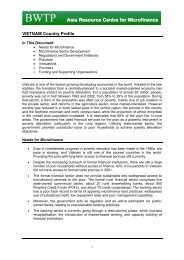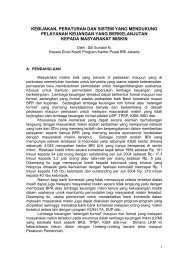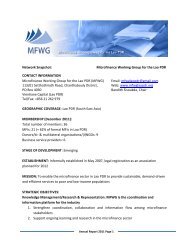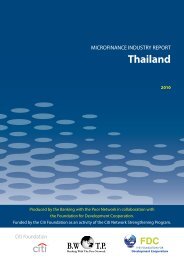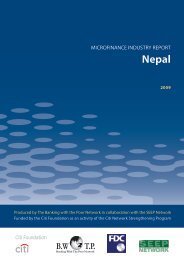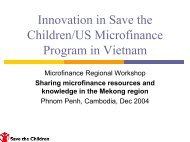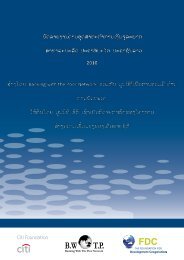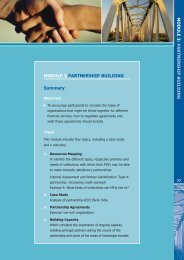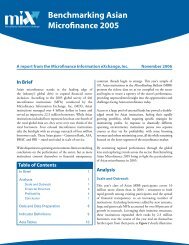microfinance industry report - Vietnam - Banking with the Poor Network
microfinance industry report - Vietnam - Banking with the Poor Network
microfinance industry report - Vietnam - Banking with the Poor Network
You also want an ePaper? Increase the reach of your titles
YUMPU automatically turns print PDFs into web optimized ePapers that Google loves.
lending rate to 18%. In June 2008, <strong>the</strong> prime was<br />
<strong>the</strong>n raised again to 14% providing a maximum<br />
lending rate of 21% p.a. It remains to be seen if this<br />
move will actually cool <strong>the</strong> frenetic credit market,<br />
but indications are that all commercial banks have<br />
hiked lending rates to <strong>the</strong> maximum.<br />
The inter-bank lending rate (refinancing rate) has<br />
also increased to 18-21% for short-term loans.<br />
The decreasing liquidity in <strong>the</strong> market has caused<br />
banks to increase interest rates paid on deposits as<br />
well. SOCB deposit rates are now around 17-17.5%<br />
p.a. while some JSBs have increased deposit rates<br />
to 19% 42 .<br />
Semi-formal MFOs, as well as future MFIs regulated<br />
under Decree 28/165 (see next section) will not be<br />
subject to <strong>the</strong> interest rate regulations.<br />
3.2 Policy, Legal and Regulatory<br />
Framework for Microfinance<br />
3.2.1 Microfinance Policy Framework<br />
There is no national <strong>microfinance</strong> strategy in<br />
Viet Nam and <strong>the</strong> principles of sustainability<br />
underpinning ‘Good Practice’ <strong>microfinance</strong> are not<br />
widely embraced in <strong>the</strong> country’s policy framework.<br />
However, <strong>the</strong>re are indications that SBV is discussing<br />
a new project that will include a component to<br />
develop a national <strong>microfinance</strong> strategy in <strong>the</strong> near<br />
future. None<strong>the</strong>less, <strong>microfinance</strong> is still widely seen<br />
as a social tool to combat poverty, and is different. It is<br />
<strong>the</strong>refore excluded from <strong>the</strong> normal workings of <strong>the</strong><br />
financial sector. This social approach is reflected in<br />
general government policies for poverty reduction,<br />
and has introduced three particular distortions in<br />
<strong>the</strong> <strong>microfinance</strong> market:<br />
>> The slow deregulation of interest rates through <strong>the</strong><br />
SOCBs (see section 3.1.1) has implicitly limited <strong>the</strong><br />
possibility of MFOs to set cost-covering interest<br />
rates.<br />
>> The continued government funding of <strong>the</strong> Viet<br />
Nam Bank for Social Policy (VBSP), which is<br />
mandated to provide supply-driven policy lending<br />
42 Communist Party of Viet Nam Online Newspaper: “Lending rate<br />
close to 21% per annum”, 25 June 2008.<br />
at unsustainably low interest rates, is tax-exempt<br />
and guaranteed by <strong>the</strong> government. The broad<br />
but non-market led outreach of this institution<br />
causes distortions in <strong>the</strong> entire financial system,<br />
and undermines sustainable <strong>microfinance</strong>. Its basic<br />
assumption that <strong>the</strong> poor are not able to afford<br />
market interest rates has been proven consistently<br />
wrong everywhere in <strong>the</strong> world. Permanent access<br />
to sustainable financial services that are provided<br />
reliably has proven to be more important than<br />
low interest rates loans provided by unsustainable<br />
institutions. There is no reason why Viet Nam<br />
should be different.<br />
>> To date, <strong>the</strong> only legal basis on which to operate<br />
<strong>microfinance</strong> in Viet Nam has been a partnership<br />
<strong>with</strong> a ‘socio-political’ Mass Organization (MO),<br />
a local People’s Committee, or a similar entity<br />
permitted by special authority to conduct financial<br />
services. MOs, <strong>with</strong> <strong>the</strong>ir broad social agenda, are<br />
well placed to facilitate mobilization of <strong>the</strong>ir poorest<br />
members, but have no reason to champion a more<br />
commercially oriented approach to <strong>microfinance</strong>,<br />
given <strong>the</strong> benefits of project funding, jobs and<br />
member services that <strong>microfinance</strong> partnerships<br />
have provided.<br />
The absence of a coherent policy environment and<br />
of a commercially-oriented <strong>microfinance</strong> <strong>industry</strong><br />
reflects <strong>the</strong> widespread perception of <strong>microfinance</strong><br />
as a poverty reduction instrument. In many respects<br />
it also reflects <strong>the</strong> larger financial sector concerns<br />
and challenges in <strong>the</strong> transition to a liberalized<br />
market economy.<br />
3.2.2 Legal and Regulatory Framework for<br />
Microfinance 43<br />
Over <strong>the</strong> past three years, <strong>the</strong> State Bank of Viet Nam<br />
has released two Decrees (Nos. 28 and 165) and one<br />
circular relating to <strong>microfinance</strong>. This is viewed by<br />
stakeholders as an opportunity for <strong>the</strong> formalization<br />
of <strong>the</strong> <strong>microfinance</strong> <strong>industry</strong>.<br />
43 Text in this section is borrowed <strong>with</strong> permission from <strong>the</strong> author,<br />
Steven Pennings (Save <strong>the</strong> Children/US) from Decree 28/165<br />
Workshop: highlights and selected issues, Viet Nam Microfinance<br />
Working Group Bulletin, Issue 11, July 2008<br />
<strong>Banking</strong> With The <strong>Poor</strong> <strong>Network</strong> 17<br />
<strong>Vietnam</strong>e_Report_FOR_PRINT.indd 17<br />
27/05/2009 7:46:01 PM



